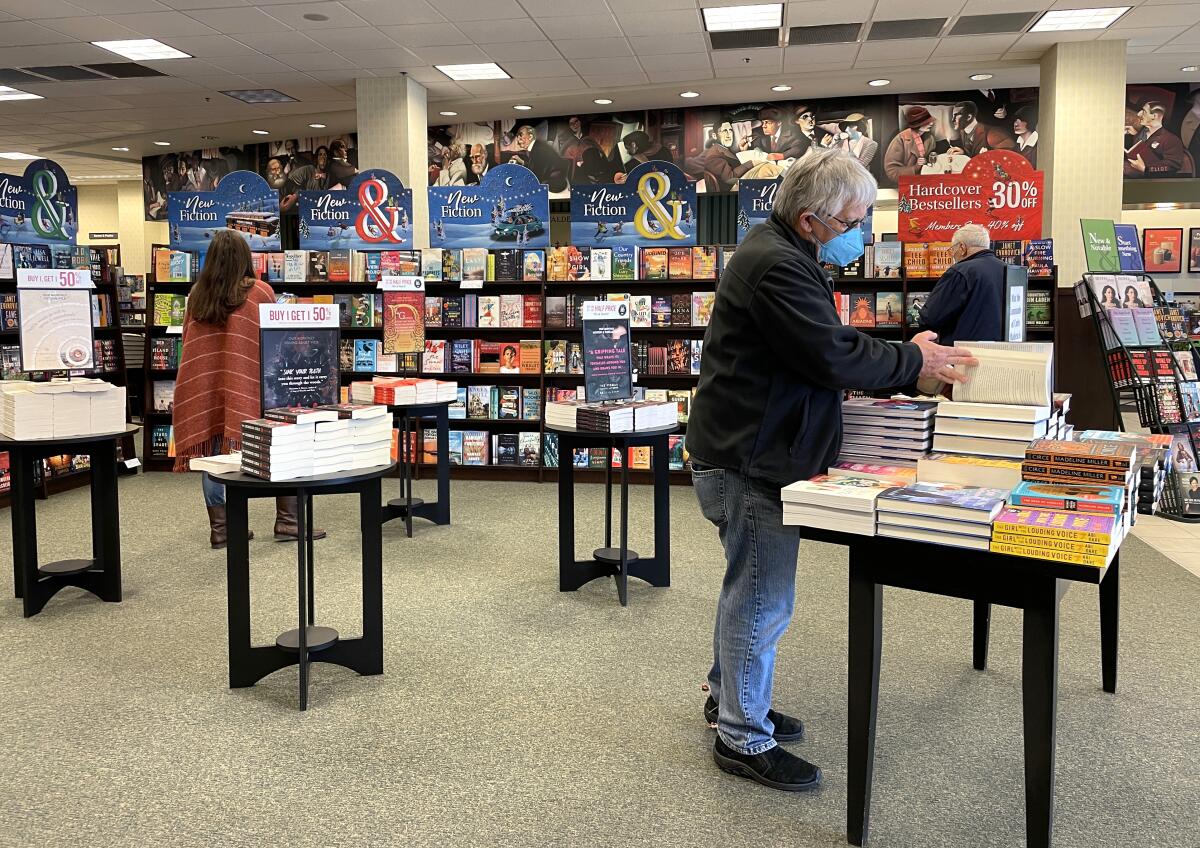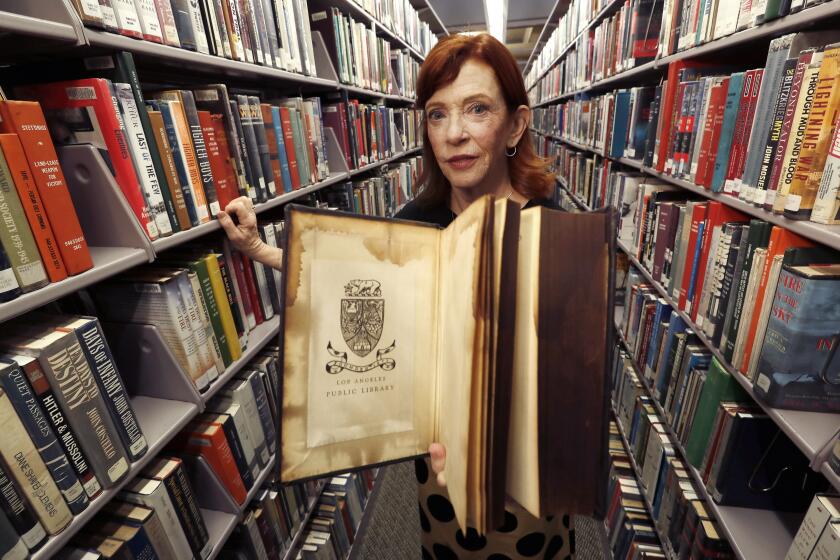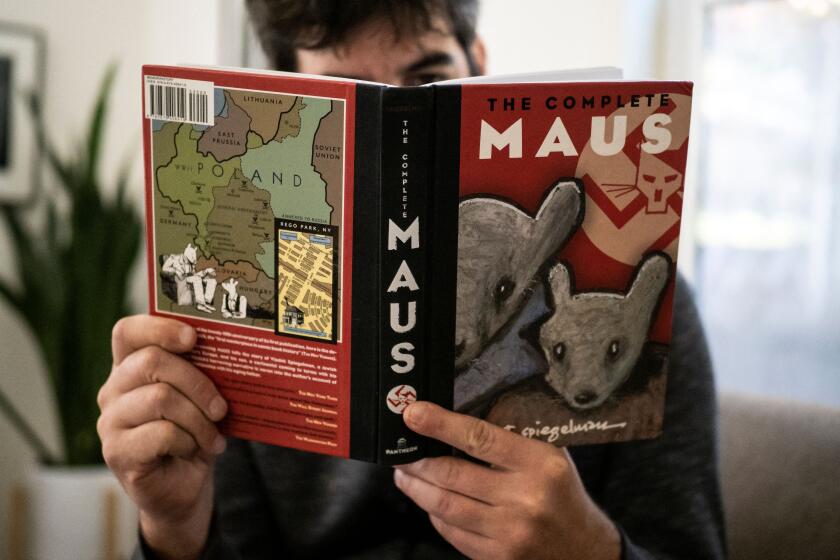Barnes & Noble saved itself by putting books first. Imagine that

- Share via
It wasn’t so long ago that Barnes & Noble seemed to be on the glide path to extinction.
At the end of 2018, the giant bookselling chain reported its seventh quarterly loss in a row, red ink of $27.3 million on sales of $117.2 million. Its management was in turmoil: That summer, Barnes & Noble fired its fourth chief executive in four years. Over the previous decade, it had closed 98 stores, shrinking its retail footprint to 630 locations from 728.
The company, now 106 years old, was facing what seemed to be inexorable competition from the e-commerce behemoth Amazon.com and a shift among readers to e-books from physical books. But its ventures to compete head-on with Amazon by bringing out a Kindle-like e-book reader called Nook and selling books online from its website have never amounted to much.
It’s all about engaging people with books.
— James Daunt, Barnes & Noble CEO
In the summer of 2019, Barnes & Noble was bought by the hedge fund Elliott Management for $683 million, almost half again what stock market investors thought it was worth.
Upon taking over, Elliott installed James Daunt as Barnes & Noble CEO. The Cambridge-educated Daunt had started his own chain of independent bookstores in Britain, then taken over as CEO of Waterstones, a floundering British bookstore chain that Elliott had acquired in June 2018.

Daunt, 59, turned the chain around to the point that he became known as “the man who saved Waterstones.” To some in the book industry, Elliott’s acquisition of Barnes & Noble looks like an effort to double down on Daunt’s management skills. (Daunt is serving as CEO of both companies.)
“Barnes & Noble was suffering a remorseless erosion of book sales as they put more and more things that weren’t books into their stores, which weren’t selling,” Daunt told me by phone from Cary, N.C., a stop on an inspection tour of Barnes & Noble stores on the Eastern Seaboard. “Since then, we’ve changed the balance of product within our stores and focused dramatically more on books.”
Get the latest from Michael Hiltzik
Commentary on economics and more from a Pulitzer Prize winner.
You may occasionally receive promotional content from the Los Angeles Times.
The result, he says, has been a “nice and healthy increase in overall sales, driven by a significant increase in book sales.” Daunt evicted “a ton of completely irrelevant products” that occupied the stores’ shelves — batteries, electronic chargers, water — “a ton of products you’d find in a CVS or Target where they perfectly sensibly sell you everything you need for everyday life, but which made absolutely no sense in a bookstore.”
What’s left are books, of course, plus some music CDs and movie DVDs, educational toys, puzzles, board games and paper goods such as journals, notebooks and greeting cards. “We concentrated on things that support the core book offer and which a book-buyer would intuitively think should be in a bookstore, including anything to do with writing.”
The cherished works from 1927 losing their copyright protection include the film ‘Metropolis,’ a classic Laurel and Hardy short and the first Hardy Boys book.
How well Barnes & Noble is doing today is a bit of a mystery because as a private company it doesn’t release profit-and-loss figures, but its publicly announced expansion plans provide a good indication. The chain is expecting to open about 30 stores this year, adding to the 22 it has opened in its last fiscal year.
If the openings proceed as planned, the chain will have slightly more stores than the 627 it operated in January 2019, before its acquisition. Many of the new locations, however, will be smaller than the megastores that were typical of the Barnes & Noble footprint of yore.
One result of the change in management is that the book industry no longer fears that Barnes & Noble will follow Borders, which went out of business in 2011, into the void — an event that would have removed miles of retail bookshelves from the market and put a serious dent in book sales.
Even some independent booksellers — a community that once saw Barnes & Noble as an evil empire — are almost relieved at its likely survival, largely because there is a greater villain in the field: Amazon.
“Our view of Barnes & Noble as a threat is different from what it was,” says Darryl Holter, co-owner of Chevalier’s Books in the Larchmont Village neighborhood of Los Angeles, “because I see them in some sense as a counterweight to Amazon — a counterweight that we can’t be because we don’t have that sort of volume.”
The apparent turnaround at Barnes & Noble isn’t entirely the product of Daunt’s strategy. In part it reflects a record surge in book sales since the start of the pandemic. The 825.7 million print books sold in 2021 were the highest total ever recorded by the sales-tracking service NPD BookScan since its launch in 2004 and a 9% increase over 2020.
Book publishing revenues rose 12.3% to a record $29.33 billion in the same period, according to the Assn. of American Publishers. As COVID restrictions ebbed in 2021, sales in bricks-and-mortar stores rose 23.9% industrywide, to $6.22 billion. Sales of trade books — that is, consumer fiction and nonfiction — rose more than 40%.
The sales surge faded somewhat in 2022 but still ran ahead of 2020.
Publishers and authors rightly fear that they’ll lose out financially from the digitization of books; but it’s also quite possible that, properly managed, the technological revolution will make them more money.
“Normally, the business is happy when sales are flat,” says Jane Friedman, a veteran consultant and commentator on publishing and writing. “Everyone in the industry agrees that James Daunt is doing the right thing. But if the publishing industry were doing poorly, Barnes & Noble would not be having a comeback.”
Indeed, Daunt acknowledged in a 2021 interview with Publishers Weekly that industry trends had been working in the company’s favor: Book sales were holding firm, rents were down and pandemic closures gave Barnes & Noble the opportunity to redesign and refurbish its stores while customers were stuck at home.
(That process was slower in California than elsewhere in the country, Daunt says, because seismic codes requiring bookshelves and display cases to be bolted to the floor made them harder to remove and reposition.)
It’s also true that Daunt’s key strategic move of giving store managers the latitude to make inventory decisions themselves rather than binding them to central ordering out of New York parallels the approach of independent bookstores nationwide.
Independents have survived “only by reaching out more effectively to their core readers in their geographic community,” Holter says.
“BN survived with new management and new policies that, ironically, mimicked tactics used by indies to survive,” Holter told me: “Reaching out to the local community, tailoring book selections to their audience, doing events, many of them virtually and then in reality.”
Still, it’s by no means easy to turn around a retail chain sticking to the hidebound practices that are sending it down the drain. On his first day at Waterstones and again at Barnes & Noble, Daunt stopped accepting the promotional payments that publishers made to dictate how their books were displayed in stores.
Daunt views promotional payments as a scourge of the bookselling trade: “Every positioning had a dollar price attached to it,” he says. The front tables, shelf arrangements, front window displays — “you pay X for this, Y for that. That worked very nicely for publishers because it gave them complete certainty and consistency across the country.”
But that ignores the basic truth that what most engages the core customers entering Barnes & Noble’s store in the Grove in Los Angeles may be rather different from the interests of customers in Cary, N.C., outside Raleigh — “different age groups, different demographics, different ethnicity.”
The old system homogenized Barnes & Noble stores coast to coast so their inventories were identical — a buyer might as well be standing at the book tables at Walmart.
“The new Michelle Obama, the new John Grisham, the new whatever-it-is is put in this position at this price,” Daunt says. “And whatever you don’t sell, you send back. For new books at Barnes & Noble, half to 70% of what came into the store would go back to the publisher. We stopped that immediately.”
Book bans become a front in the partisan culture war
He encouraged store staff to organize their inventories not only to appeal to local interests, but also to facilitate the one quality of bricks-and-mortar stores that online merchants have never been able to replicate — the ease of browsing and discovering new things by walking around.
“The old Barnes & Noble was serried ranks of bookshelves, most sections arranged A to Z by author,” Daunt says. That works for customers who come through the door knowing what they want to buy and wanting to find it promptly.
That structure, however, contributed to making the company’s bookstores “crucifyingly boring,” as Daunt put it at a book conference soon after taking over. Instead, “our job is to create bookstores which are attractive for browsing, where people want to spend time and discover books.”
Instead of arranging the history section by authors’ names, for instance, they should be organized chronologically.
Horror sections arranged by author mix literary horror writers such as Edgar Allan Poe and Shirley Jackson in with schlock — “covers with fangs and blood — I don’t have anything against schlock, but why not split your horror section into literary horror and schlocky horror, and that for a browser that becomes much more harmonious and much more interesting.”
The apparent recovery of Barnes & Noble is getting attention because it hints at how bricks-and-mortar retailing can be sustained in a world of online commerce. In brief, put management in the hands of people who understand their community and who understand their products.
“The key element” in Barnes & Noble’s turnaround, former venture investor (and Stanford music historian) Ted Gioia wrote recently on his blog, “is putting books and readers first, and everything else second. ... Creative fields like music and writing live and die based on creativity, not financial statements and branding deals.”
And Daunt loves books. He says he always has a serious nonfiction book with him on his travels (“It’s how I try to keep educating myself”) and keeps abreast of new fiction — he’s just finished “a completely marvelous and astonishing novel”; it’s “This Other Eden” by Paul Harding, who won the Pulitzer Prize for his first novel, “Tinkers,” in 2010.
Daunt describes his remaking of Barnes & Noble as a work in progress. Whether the pandemic sales surge will be sustained is unclear; Amazon still dominates the online sales market, which still accounts for nearly 45% of trade book sales; new forms of entertainment, newly accessible with the end of pandemic restrictions, will always threaten to cut into the book business.
But Daunt is confident that the creation of spaces where people can discover new books and new interests will help Barnes & Noble survive. “Keep coming into my bookstores, because if you do, I’ve got you. It’s all about engaging people with books.”
More to Read
Get the latest from Michael Hiltzik
Commentary on economics and more from a Pulitzer Prize winner.
You may occasionally receive promotional content from the Los Angeles Times.














